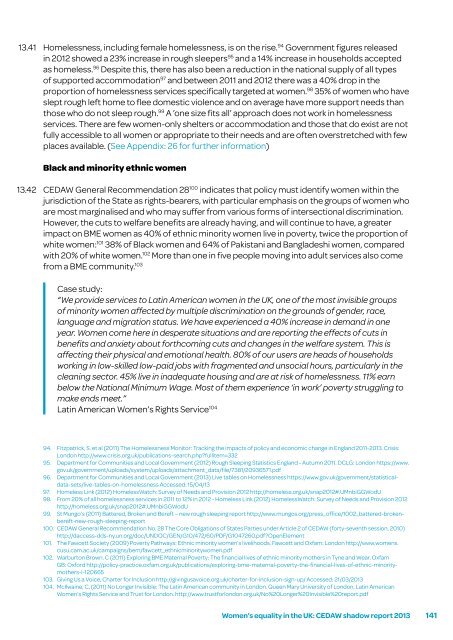Women’s equality in the UK – A health check
Women’s equality in the UK – A health check
Women’s equality in the UK – A health check
Create successful ePaper yourself
Turn your PDF publications into a flip-book with our unique Google optimized e-Paper software.
13.41<br />
13.42<br />
Homelessness, <strong>in</strong>clud<strong>in</strong>g female homelessness, is on <strong>the</strong> rise. 94 Government figures released<br />
<strong>in</strong> 2012 showed a 23% <strong>in</strong>crease <strong>in</strong> rough sleepers 95 and a 14% <strong>in</strong>crease <strong>in</strong> households accepted<br />
as homeless. 96 Despite this, <strong>the</strong>re has also been a reduction <strong>in</strong> <strong>the</strong> national supply of all types<br />
of supported accommodation 97 and between 2011 and 2012 <strong>the</strong>re was a 40% drop <strong>in</strong> <strong>the</strong><br />
proportion of homelessness services specifically targeted at women. 98 35% of women who have<br />
slept rough left home to flee domestic violence and on average have more support needs than<br />
those who do not sleep rough. 99 A ’one size fits all’ approach does not work <strong>in</strong> homelessness<br />
services. There are few women-only shelters or accommodation and those that do exist are not<br />
fully accessible to all women or appropriate to <strong>the</strong>ir needs and are often overstretched with few<br />
places available. (See Appendix: 26 for fur<strong>the</strong>r <strong>in</strong>formation)<br />
Black and m<strong>in</strong>ority ethnic women<br />
CEDAW General Recommendation 28 100 <strong>in</strong>dicates that policy must identify women with<strong>in</strong> <strong>the</strong><br />
jurisdiction of <strong>the</strong> State as rights-bearers, with particular emphasis on <strong>the</strong> groups of women who<br />
are most marg<strong>in</strong>alised and who may suffer from various forms of <strong>in</strong>tersectional discrim<strong>in</strong>ation.<br />
However, <strong>the</strong> cuts to welfare benefits are already hav<strong>in</strong>g, and will cont<strong>in</strong>ue to have, a greater<br />
impact on BME women as 40% of ethnic m<strong>in</strong>ority women live <strong>in</strong> poverty, twice <strong>the</strong> proportion of<br />
white women: 101 38% of Black women and 64% of Pakistani and Bangladeshi women, compared<br />
with 20% of white women. 102 More than one <strong>in</strong> five people mov<strong>in</strong>g <strong>in</strong>to adult services also come<br />
from a BME community. 103<br />
Case study:<br />
“We provide services to Lat<strong>in</strong> American women <strong>in</strong> <strong>the</strong> <strong>UK</strong>, one of <strong>the</strong> most <strong>in</strong>visible groups<br />
of m<strong>in</strong>ority women affected by multiple discrim<strong>in</strong>ation on <strong>the</strong> grounds of gender, race,<br />
language and migration status. We have experienced a 40% <strong>in</strong>crease <strong>in</strong> demand <strong>in</strong> one<br />
year. Women come here <strong>in</strong> desperate situations and are report<strong>in</strong>g <strong>the</strong> effects of cuts <strong>in</strong><br />
benefits and anxiety about forthcom<strong>in</strong>g cuts and changes <strong>in</strong> <strong>the</strong> welfare system. This is<br />
affect<strong>in</strong>g <strong>the</strong>ir physical and emotional <strong>health</strong>. 80% of our users are heads of households<br />
work<strong>in</strong>g <strong>in</strong> low-skilled low-paid jobs with fragmented and unsocial hours, particularly <strong>in</strong> <strong>the</strong><br />
clean<strong>in</strong>g sector. 45% live <strong>in</strong> <strong>in</strong>adequate hous<strong>in</strong>g and are at risk of homelessness. 11% earn<br />
below <strong>the</strong> National M<strong>in</strong>imum Wage. Most of <strong>the</strong>m experience ‘<strong>in</strong> work’ poverty struggl<strong>in</strong>g to<br />
make ends meet.”<br />
Lat<strong>in</strong> American <strong>Women’s</strong> Rights Service 104<br />
94. Fitzpatrick, S. et al (2011) The Homelessness Monitor: Track<strong>in</strong>g <strong>the</strong> impacts of policy and economic change <strong>in</strong> England 2011-2013. Crisis:<br />
London http://www.crisis.org.uk/publications-search.php?fullitem=332<br />
95. Department for Communities and Local Government (2012) Rough Sleep<strong>in</strong>g Statistics England - Autumn 2011. DCLG: London https://www.<br />
gov.uk/government/uploads/system/uploads/attachment_data/file/7381/20936571.pdf<br />
96. Department for Communities and Local Government (2013) Live tables on Homelessness https://www.gov.uk/government/statisticaldata-sets/live-tables-on-homelessness<br />
Accessed: 15/04/13<br />
97. Homeless L<strong>in</strong>k (2012) HomelessWatch: Survey of Needs and Provision 2012 http://homeless.org.uk/snap2012#.UMnbiGGWodU<br />
98. From 20% of all homelessness services <strong>in</strong> 2011 to 12% <strong>in</strong> 2012 - Homeless L<strong>in</strong>k (2012) HomelessWatch: Survey of Needs and Provision 2012<br />
http://homeless.org.uk/snap2012#.UMnbiGGWodU<br />
99. St Mungo’s (2011) Battered, Broken and Bereft <strong>–</strong> new rough sleep<strong>in</strong>g report http://www.mungos.org/press_office/1002_battered-brokenbereft-new-rough-sleep<strong>in</strong>g-report<br />
100. CEDAW General Recommendation No. 28 The Core Obligations of States Parties under Article 2 of CEDAW (forty-seventh session, 2010)<br />
http://daccess-dds-ny.un.org/doc/UNDOC/GEN/G10/472/60/PDF/G1047260.pdf?OpenElement<br />
101. The Fawcett Society (2009) Poverty Pathways: Ethnic m<strong>in</strong>ority women’s livelihoods. Fawcett and Oxfam: London http://www.womens.<br />
cusu.cam.ac.uk/campaigns/bem/fawcett_ethnicm<strong>in</strong>oritywomen.pdf<br />
102. Warburton Brown. C (2011) Explor<strong>in</strong>g BME Maternal Poverty: The f<strong>in</strong>ancial lives of ethnic m<strong>in</strong>ority mo<strong>the</strong>rs <strong>in</strong> Tyne and Wear. Oxfam<br />
GB: Oxford http://policy-practice.oxfam.org.uk/publications/explor<strong>in</strong>g-bme-maternal-poverty-<strong>the</strong>-f<strong>in</strong>ancial-lives-of-ethnic-m<strong>in</strong>oritymo<strong>the</strong>rs-i-120665<br />
103. Giv<strong>in</strong>g Us a Voice, Charter for Inclusion http://giv<strong>in</strong>gusavoice.org.uk/charter-for-<strong>in</strong>clusion-sign-up/ Accessed: 21/03/2013<br />
104. McIlwa<strong>in</strong>e, C. (2011) No Longer Invisible: The Lat<strong>in</strong> American community <strong>in</strong> London. Queen Mary University of London, Lat<strong>in</strong> American<br />
<strong>Women’s</strong> Rights Service and Trust for London. http://www.trustforlondon.org.uk/No%20Longer%20Invisible%20report.pdf<br />
<strong>Women’s</strong> <strong>equality</strong> <strong>in</strong> <strong>the</strong> <strong>UK</strong>: CEDAW shadow report 2013 141


